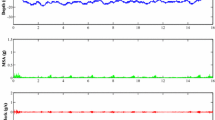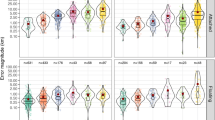Abstract
Obtaining extended and detailed information from instrumented whales is important for understanding whale behavior and interpreting responses to anthropogenic noise but has been difficult to achieve with tags because of short attachment times, poor spatial/temporal resolution, or lack of adequate acoustic data. In 2007–2008, sperm whales were tagged in the Gulf of California with Wildlife Computers TDR-PAT-MK-10 tags. While attached, the tags sent Fastloc-GPS locations and summary dive data (shape, duration, and depth) via ARGOS after dives >10 min and >10 m. Tags released from the whales floated to the surface and were recovered. Downloaded data revealed high-resolution time-depth recorder (TDR; 1-s and 2-m dive-depth increments) and GPS data within 60 m (Mate 2008). The tags provided insights into resting, foraging, and traveling behaviors, diving to depths over 1,200 m for periods of up to 28 days. Fast zigzag patterns during dives likely represented foraging attempts on Humboldt squids. Despite coordinated travels, whales in the same social unit did not usually dive synchronously or to the same depth and displayed considerable variability at the same position and time.
Access provided by Autonomous University of Puebla. Download conference paper PDF
Similar content being viewed by others
Keywords
These keywords were added by machine and not by the authors. This process is experimental and the keywords may be updated as the learning algorithm improves.
1 Introduction
Obtaining extended and detailed information from instrumented whales is important for understanding whale behavior and interpreting responses to anthropogenic noise but has been difficult to achieve with tags because of short attachment times, poor spatial/temporal resolution, or lack of adequate acoustic data. In 2007–2008, sperm whales were tagged in the Gulf of California with Wildlife Computers TDR-PAT-MK-10 tags. While attached, the tags sent Fastloc-GPS locations and summary dive data (shape, duration, and depth) via ARGOS after dives >10 min and >10 m. Tags released from the whales floated to the surface and were recovered. Downloaded data revealed high-resolution time-depth recorder (TDR; 1-s and 2-m dive-depth increments) and GPS data within 60 m (Mate 2008). The tags provided insights into resting, foraging, and traveling behaviors, diving to depths over 1,200 m for periods of up to 28 days. Fast zigzag patterns during dives likely represented foraging attempts on Humboldt squids. Despite coordinated travels, whales in the same social unit did not usually dive synchronously or to the same depth and displayed considerable variability at the same position and time.
A principal components analysis (PCA) was used to detect changes in dive behavior during a sperm whale’s GPS/TDR dive record over a 28-day period as it moved from 14 days in a deep-water habitat to 14 days in a shallow-water habitat (Fig. 1). The technique was sufficiently sensitive to identify changes in the first 5 dives of the shallow-water habitat as substantially different from those of the previous 5 or 14 days of deep-water dives. The whale did not consistently dive to the bottom, so these differences were not just a reflection of bottom depth. This environmental change probably affected the behavior of squid, sperm whale prey, and therefore sperm whale dive behavior. The detection of this dive change was possible from the ARGOS-relayed summary dive data (and thus feasible with near real-time monitoring) rather than having to wait for the detailed dive data obtainable only by recovering the tag at the end of the experiment. This could be important for a controlled-exposure experiment (CEE) or behavioral-response study (BRS) strategy designed to expose animals to sequentially higher levels of sound so there is a means of recognizing changes in dive behavior in real time to avoid extreme noise exposures, which may be injurious or problematic for the subject animals. The capability of maintaining tags on animals for longer periods of time and monitoring their responses to sound exposures allows for adaptive modifications in the experimental exposure protocol, which can potentially document recovery from temporary effects, changes in response to repeat exposures, and possible habituation.
The movement of a sperm whale equipped with a Wildlife Computers GPS/TDRPAT-MK-10 tag in the central Gulf of California during 14 days of dives in deep water to the south (left) and 14 days of dives in shallower water to the north (right). The view is from the east looking west over Tiburon Island in the foreground
Although we used an environmental change rather than a noise as a “change proxy,” these results provide evidence that the tag technologies (attachments, GPS, and dive-sensing records), data gathered, and the PCA tools can inform a dose-response experiment involving noise and dive behavior changes.
The extent to which whales change their behavior in the presence of anthropogenic sound is still in doubt for most whale species. Although it seems intuitive that loud sounds like military sonar systems and seismic surveys might affect the habits of whales, their underwater behaviors are difficult to study. It is also hard to understand why whales do not always respond to the noises of ships by getting out of the way (Berman-Kowalewski et al. 2010) The development of long-term satellite tracking of whales (Mate et al. 2007) and sophisticated geographic information system analyses (Bailey et al. 2010) now make it possible to do both broad-scale habitat characterization (Cotte et al. 2009) and the collection of detailed diving behavior (Mate 2008).
The development of an acoustic dosimeter is underway at Cornell University, Ithaca, NY (C. Clark, personal communication) and will be incorporated into the next generation of the GPS/TDR tag. It will provide detailed records of up to five predetermined acoustic events designed to provide insight into how anthropogenic noise affects whale behavior during future CEEs or BRSs lasting over a month. The dosimeter is being incorporated into the GPS/TDR tag structure but is totally self-sufficient. It measures the sound exposure level (SEL) for echolocation clicks, codas, creaks (a proxy for a foraging attempt), vessel noise, and seismic/sonar sources during 5-min summary periods. The GPS/TDR-acoustic dosimeter tags will record GPS locations and the depth of whale dives every 2 s as well as the SEL and time stamp of the preselected acoustic events. Thus the tags will provide a huge database including pre- and postexposure dive behavior during “control” periods and noise-exposure events. Potential responses to experimental noises can then be viewed in the context of nonexposure (control) variability. Analyses will be undertaken to look for possible effects of just vessel noise in the absence of intentional exposures, which may help inform if and how whales respond to the approach of vessels.
The highest accumulated sound level will be measured for each acoustic event category occurring every 5 min, integrating over full 1-s periods, not just the highest sound pressure level value. Before field deployment, the dosimeter will be tested in conjunction with a calibrated acoustic buoy to affirm the quality of its measurements.
The tags come off 1) at a preset date and time, 2) if they don’t change water depth for an extended period of time (suggesting they have come off the animal and sunk to the bottom in their attachment sleeve), or 3) when the tag batteries are down to 25% of their capacity. The final criterion ensures sufficient battery power for the tag to send its GPS location so it can be located for recovery. The tag-recovery vessel uses the ARGOS-relayed or tag-uplink GPS message in a Fastloc proprietary software system and the vessel’s own GPS system to display the relative position of the vessel to the tag.
The first application of these amalgamated technologies is likely to be on blue and fin whales in the southern Gulf of California during the 2010 Southern California BRS. For this study, the measured wave forms will be 1) low-frequency social vocalizations, 2) ship noise, 3) naval sonar, and 4) pseudonoise of the same frequency range as the sonar source but with different time characteristics. Although we do not expect social vocalizations to be very routine in August when we start this experiment with blue/fin whales, we will determine if their vocalization rate changes in response to dive depths, noise exposure, or time of day. During that experiment, other team participants will be applying B-probes, and it is hoped that the double tagging of individual whales will provide a cross-correlation between the two techniques.
2 Conclusions
The long-term attachment of GPS/TDR tags can provide detailed data over extended periods before, during, and after the CEE/BRS. The incorporation of an acoustic dosimeter into this tag provides the information on SELs for biologic sources (vocalizations, clicks, codas, and creaks) and anthropogenic noises, both controlled (seismic or sonar) as well as uncontrolled (ship noise). PCA techniques can recognize changes in dive behavior when whales move between different habitat types from both ARGOS-relayed summary dive data and detailed TDR data on tag recovery, suggesting that significant noise-induced charges will also be detectable.
References
Bailey H, Mate BR, Palacios DM, Irvine L, Bograd SJ, Costa DP (2010) Behavioural estimation of blue whale movements in the Northeast Pacific from state-space model analysis of satellite tracks. Endang Species Res 10:93–106.
Berman-Kowalewski M, Gulland F, Wilkin S, Calambokidis J, Mate BR, Cordaro J, Rotstein D, St. Leger J, Collins P, Fahy K, Dover S (2010) Association between blue whale mortality and ship strikes along the California coast. Aquat Mamm 36:59–66.
Cotte C, Guinet C, Taupeir-Letage I, Mate B, Petiau E (2009) Scale-dependent habitat use by a large free-ranging predator, the Mediterranean fin whale. Deep-Sea Res Part I Oceanogr Res Pap 56:801–811.
Mate BR (2008) Technical instrumentation issues related to the design and execution of a controlled-exposure experiment for larger cetaceans to assess possible behavioural responses and potential impacts. Bioacoustics 17:334–336.
Mate B, Mesecar R, Lagerquist B (2007) The evolution of satellite-monitored radio tags for large whales: One laboratory’s experience. Deep-Sea Res Part II Top Stud Oceanogr 54:224–247.
Author information
Authors and Affiliations
Corresponding author
Editor information
Editors and Affiliations
Rights and permissions
Copyright information
© 2012 Springer Science+Business Media, LLC
About this paper
Cite this paper
Mate, B.R. (2012). Implementation of Acoustic Dosimeters With Recoverable Month-Long GPS/TDR Tags to Interpret Controlled-Exposure Experiments for Large Whales. In: Popper, A.N., Hawkins, A. (eds) The Effects of Noise on Aquatic Life. Advances in Experimental Medicine and Biology, vol 730. Springer, New York, NY. https://doi.org/10.1007/978-1-4419-7311-5_45
Download citation
DOI: https://doi.org/10.1007/978-1-4419-7311-5_45
Publisher Name: Springer, New York, NY
Print ISBN: 978-1-4419-7310-8
Online ISBN: 978-1-4419-7311-5
eBook Packages: Biomedical and Life SciencesBiomedical and Life Sciences (R0)






